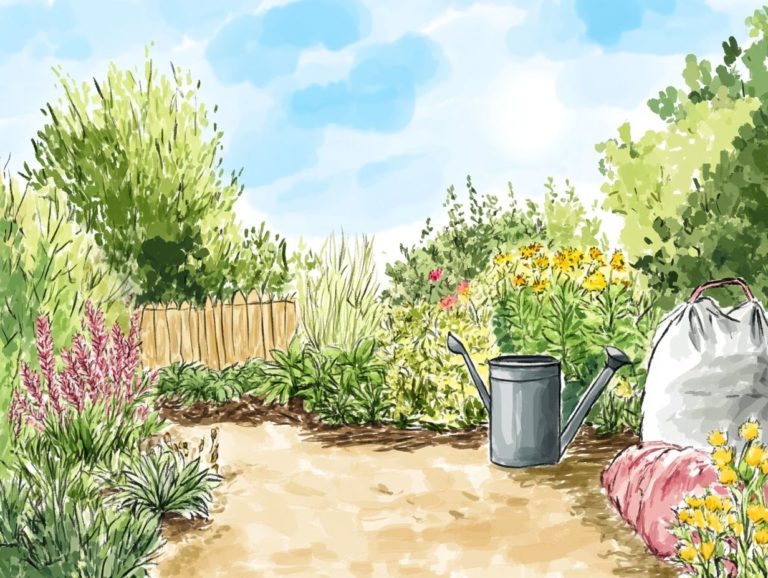How to Deal with Extreme Heat
As temperatures rise, understanding extreme heat is crucial. This article explains extreme heat. It covers its physical and mental effects and offers tips to avoid heat-related illnesses.
You ll learn to identify symptoms and know when to seek help. We ll also cover essential steps to prepare for rising temperatures. Stay informed and prepared to protect yourself and your loved ones during these hot months.
Contents
- Key Takeaways:
- Understanding Extreme Heat
- Effects of Extreme Heat on the Body
- Preventing Heat-Related Illnesses
- Treating Heat-Related Illnesses
- Preparing for Extreme Heat
- Frequently Asked Questions
- 1. How do I stay cool during extreme heat?
- 2. Can extreme heat be dangerous for my health?
- 3. How can I protect my pets from extreme heat and ensure their hydration?
- 4. What should I do if I start feeling ill due to extreme heat and experience symptoms like dehydration?
- 5. How do I prepare my home for extreme heat?
- 6. Is it safe to exercise outdoors during extreme heat, considering high temperatures and humidity?
Key Takeaways:
- Stay hydrated and avoid strenuous activity during extreme heat to prevent heat-related illnesses.
- Recognize symptoms of heat exhaustion and heat stroke and seek immediate medical help if necessary.
- Prepare for extreme heat by creating a plan and having necessary supplies, like sunscreen and water.
Understanding Extreme Heat
Understanding extreme heat is essential in today’s world, where climate change has ushered in soaring temperatures and heightened humidity that can pose significant health risks.
The National Weather Service defines extreme heat as occurring when the heat index hits or surpasses 100 degrees Fahrenheit for extended periods. This issue is especially alarming in regions like the Northeast and Midwest, where temperature records have been broken in recent years. This underscores the urgent need for awareness and preparedness.
Extreme heat is defined as prolonged high temperatures that can trigger health alerts and emergencies, especially when temperature records spike beyond the usual seasonal averages.
Health organizations like the CDC consider extreme heat to occur when the heat index surpasses 100 F or when nighttime temperatures remain above 70 F, making it increasingly challenging for your body to cool itself down. These sweltering conditions aren’t just uncomfortable; they heighten the risk of heat-related illnesses, such as heat exhaustion and heat stroke. Those most at risk include the elderly, young children, and individuals with preexisting health conditions.
That s why issuing heat alerts is so vital it raises awareness and encourages everyone to take the necessary precautions to stay safe during such extreme weather events.
Effects of Extreme Heat on the Body
Extreme heat can profoundly affect your body, leading to serious conditions like heat exhaustion and heat stroke, which can escalate to life-threatening situations if not addressed swiftly.
When your body temperature climbs due to excessive sunlight exposure and dehydration, you might encounter a variety of symptoms, including dizziness, nausea, and confusion. Awareness of these effects is vital for your safety!
Recognizing the signs early on can make all the difference in ensuring safety and well-being.
Physical and Mental Impact

The physical and mental toll of extreme heat can be overwhelming. Dehydration and heat-related illnesses significantly disrupt your bodily functions and cognitive abilities.
These conditions can escalate into serious health risks, such as heat cramps, heat exhaustion, and even heat stroke, particularly during the sweltering summer months. It s essential for you to prioritize hydration by drinking plenty of water and incorporating electrolyte-rich beverages, as these will effectively replenish lost minerals and keep your body functioning at its best.
Utilizing cooling methods like wet cloths, fans, or air conditioning not only aids in lowering your body temperature but also enhances your mental well-being by alleviating the discomfort and fatigue that come with excessive heat.
Preventing Heat-Related Illnesses
Preventing heat-related illnesses should be a top priority during the summer months! Soaring temperatures can lead to serious health issues if you don t take the right precautions.
Stay hydrated! It s one of the best things you can do! Make sure you re drinking plenty of water and consider electrolyte drinks, which help replenish essential minerals lost through sweat. Don t overlook the value of local cooling centers and the importance of looking out for your neighbors.
By fostering a spirit of community awareness, you can play a significant role in reducing the risk of heat-related illnesses, especially for vulnerable groups like the elderly and young children.
Tips for Staying Safe in Extreme Heat
- Wear light clothing.
- Stay indoors during peak sun hours.
- Utilize cooling methods like cold baths and fans.
- Drink plenty of water throughout the day to help regulate your body temperature.
- Adjust your schedule to tackle strenuous activities during the cooler parts of the day.
- Stay informed about local weather forecasts and heat alerts to know when to take extra precautions.
- Engage with community support services, such as local cooling centers or outreach programs for vulnerable populations, to access additional resources.
Treating Heat-Related Illnesses
Addressing heat-related illnesses is crucial, especially for young children and the elderly, who are particularly vulnerable to conditions like heat exhaustion and heat stroke.
Recognizing symptoms such as confusion, rapid pulse, and unconsciousness can prompt timely intervention, which is vital for effective treatment and recovery.
Having immediate access to emergency services can significantly influence health outcomes during extreme heat events, ensuring that those affected receive the care they need when it matters most.
Recognizing Symptoms and Seeking Help

Recognizing the signs of heat exhaustion and heat stroke is absolutely crucial! Both conditions can escalate swiftly, demanding immediate action and potentially the involvement of emergency services.
Heat exhaustion often presents with heavy sweating, weakness, dizziness, and nausea all signals that your body is struggling to cool itself. On the other hand, heat stroke is marked by a high body temperature, confusion, or an altered mental state, transforming it into a potentially life-threatening emergency.
Monitor your hydration levels closely, as dehydration can significantly amplify these symptoms. If any signs persist or worsen especially if your core temperature exceeds 104 F don t hesitate! Seek medical assistance immediately. Taking swift action can prevent serious complications down the line.
Preparing for Extreme Heat
Preparing for extreme heat requires thoughtful planning and awareness! Ensure that you and your community are equipped with effective cooling strategies and proper hydration methods.
Given the rising frequency of extreme weather events due to climate change, it s crucial to establish a preparedness plan that includes access to cooling centers and information about local emergency services.
By taking this proactive approach, you can significantly mitigate the risks associated with heat-related health issues during heat waves.
Steps to Take Before Extreme Heat Occurs
Taking proactive steps before extreme heat strikes can significantly reduce health risks and enhance community safety, with a strong emphasis on hydration and access to cooling centers.
You should prioritize drinking plenty of water in the days leading up to a heat wave to ensure your body stays well-hydrated. It’s smart to have cooling tools ready, such as fans or air conditioning units. Look for nearby cooling centers, which are places like community centers that offer air conditioning, where you can seek refuge during peak temperatures.
Engaging in community support systems like organizing block parties or neighborhood check-ins can create a strong sense of solidarity and provide assistance to those who are more vulnerable. Public health awareness campaigns are essential for educating residents about these preventative measures, ultimately boosting your community s readiness and resilience against the dangers of extreme heat.
Frequently Asked Questions
1. How do I stay cool during extreme heat?
To stay cool during extreme heat, it’s vital to stay hydrated by drinking plenty of water and avoiding alcoholic and caffeinated beverages. You can also stay indoors in air-conditioned spaces, wear light and loose clothing, and take cool showers or baths to help regulate your body temperature.
2. Can extreme heat be dangerous for my health?
Yes, extreme heat can be dangerous for your health. It can cause heat exhaustion, heat stroke, and dehydration, which can lead to serious health issues such as organ damage and even death. Taking precautions is vital!
3. How can I protect my pets from extreme heat and ensure their hydration?
To protect your pets from extreme heat, make sure they have access to fresh water at all times and keep them in a cool, shaded area. Avoid exercising or taking them for walks during the hottest parts of the day. You can also provide them with cooling mats or frozen treats to help them stay cool.
4. What should I do if I start feeling ill due to extreme heat and experience symptoms like dehydration?
If you start feeling ill due to extreme heat, immediately move to a cool place and drink water! If your symptoms persist or worsen, seek medical attention. Symptoms of heat illness can include dizziness, nausea, headache, and confusion.
5. How do I prepare my home for extreme heat?
To prepare for extreme heat in your home, make sure your air conditioning is in good working condition and have a backup plan in case of power outages. You can also install window shades or use reflective window coatings to reduce the amount of heat entering your home. Don’t forget to stock up on water and non-perishable foods in case of emergencies.
6. Is it safe to exercise outdoors during extreme heat, considering high temperatures and humidity?
No, it is not safe to exercise outdoors during extreme heat. The high temperatures and humidity can put a strain on your body and increase your risk of heat-related illnesses. It’s best to exercise indoors or during cooler times of the day if possible. If you must exercise outdoors, make sure to stay hydrated and take frequent breaks in a cool, shaded area.







